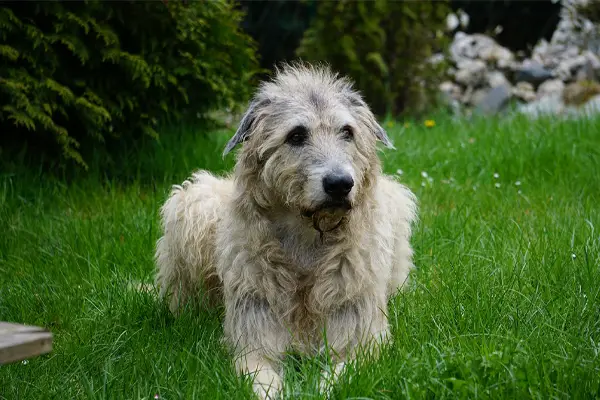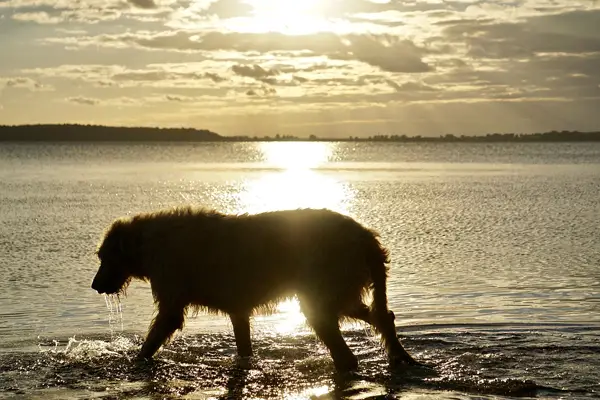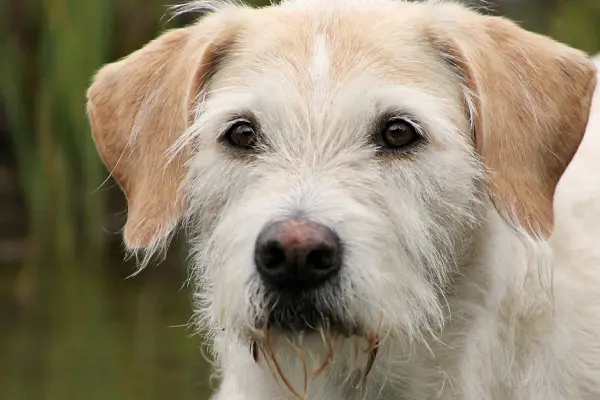Irish Wolfhounds are giant-sized dogs from the hound group that are larger than Greyhounds. Despite their massive size, the Irish Wolfhound is gentle and big-hearted. They have a sturdy body covered with a hard coat that comes in beautiful colors of gray, brindle, red, black, white, or fawn.
Irish Wolfhounds are considered to be the tallest of all dog breeds and the largest of all sighthounds. They are known for being swift runners with the ability to kill large animals. This is not the type of breed that anyone can take care of.
Their massive size already entails that they need ample space. Their short lifespan already speaks that they need a lot of care. For the right person, however, these dogs are the best companions. They will offer you a lot of love, admiration, and kisses.

Irish Wolfhound Statistics
| Dog Breed Group | Hound |
| Breed Size | Giant |
| Height | 32 inches minimum (male); 30 inches minimum (female) |
| Weight | 120 pounds (male); 105 pounds (female) |
| Lifespan | 6-8 years |
Irish Wolfhound Ratings
| Energy level | |
| Exercise needs | |
| Requires attention | |
| Playfulness | |
| Trainability | |
| Shedding | |
| Grooming | |
| Friendly with family | |
| Friendly with kids | |
| Friendly with strangers | |
| Friendly with other dogs | |
| Prey Drive |
Irish Wolfhound History
For centuries, the Irish Wolfhound has been a marvelous sight and was named the “Great Hound of Ireland.” The dogs have a long history that goes way back to 391 AD in Rome, where they were famed as gladiators and coursers.
With their enormous size, these dogs are fearsome in battle. They were mainly used as war dogs, pulling men down from their horses and chariots. Other than that, they also hunted elks, boars, and wolves, while others used them to guard their homes and livestock.
Because of the dog’s bravery, an Irish law was established that only kings and nobles were allowed to own the dog breed. They became status symbols and prestige. They also became popular gifts between rulers and usually arrived with chains and collars of gold and silver.
In the 15th century, these dogs became renowned hunters, and their importance was always specified. However, enter the 1700s, the dogs’ numbers started to decrease as big-game animals were hunted to extinction.
Irish Wolfhounds were no longer of use, and they too almost went extinct. Fortunately, in 1862, an army captain, George Augustus Graham, started looking for the dog breed to revive them. He spent his life promoting, protecting and standardizing the breed to what we know of it now.
Graham founded the Irish Wolfhound Club in 1885. By 1897, the American Kennel Club followed through and recognized the dog breed. But it took several years before England’s Kennel Club officially recognized the breed in 1925.
The Irish Wolfhound currently ranks 77th as the most popular dog breed in the US. And though they are no longer battle dogs, they make excellent members of the family.

Irish Wolfhound Temperament
The American Kennel Club describes the Irish Wolfhound as courageous, dignified, and calm. These dogs are known to have hearts as big as their size. They are extremely gentle, and they thrive for human companionship.
Irish Wolfhounds treats family members different from the rest. They’re temperaments vary from being calm and dignified to being playful and silly. But most of the time, these dogs are easy-going.
They need ample space to stretch indoors, and a large area to run around outdoors. Most of the time, they prefer being indoors and will not go for a run, but it is highly recommended to take them out daily.
They do love to chase around little animals outside, so it’s best to keep them on a secured fence. They also make great playmates for older children while they need supervision with toddlers. They are also good with other dogs and animals.
Even though their size is intimidating, Irish Wolfhounds are not great guard dogs. These dogs are naturally friendly, even with strangers. They may stand alert, but they’re never aggressive.
Training will not be as hard even with the sense of independence of the dog breed. As long as you approach them patiently and give firm leadership, your Irish Wolfhound will be happy to follow. Early socialization is essential to make them more well-rounded dogs.
Irish Wolfhound Care Requirements
- Nutrition: Irish Wolfhounds don’t need a special diet. But they do need a high-quality and well-balanced diet that contains all the essential nutrients – proteins, fats, carbohydrates, vitamins, and minerals. They need an average calorie intake of 2839 calories, while the active ones would need more (about 3154 kcal). You should watch out for their consumption and make sure that they don’t go overweight as this can cause health problems. Protein is the essential component of this dog’s diet. It’s also the majority of their food. It is recommended that they take around 22% of protein as puppies while 18% are for adult dogs. As for the fat, this must comprise at least 8% of the dog’s diet. It’s essential to provide high-quality ingredients only. Get protein from high-quality animal meat, fats from fish and chicken oil, carbohydrates from whole grains, and vitamins from fruits and vegetables. For dog food, only but those that are of premium quality. Look out for fillers and additives, which can cause problems for your dog’s digestion.
- Grooming: The bodies of Irish Wolfhounds are covered with a harsh, wiry coat that sheds seasonally. Weekly brushing is highly recommended to remove loose hair, mats, tangles, and any debris that is stuck in their hair. This will also help in keeping him look his best. Baths can be given occasionally, depending on how dirty they are. But ears should be cleaned regularly. Don’t forget to check and trim the nails always. Long nails will cause discomfort and pain, especially when your Irish Wolfhound is running.
- Exercise: Irish Wolfhounds need regular exercise throughout their lives. It’s not their favorite, but it will help keep them fit and away from health conditions that mostly affect their bones. If you let them loose, make sure that the area is fenced and secured. If not, always keep him on-leash. They have strong instincts to chase and hunt prey, especially as puppies. As these dogs grow older, they tend to become lazier. With that, you must take them on a daily walk even if it’s only for an hour. You can also create some activities that you can do together to make things more fun for your dog. If you like it, you can also participate in canine sports like tracking, agility, and lure coursing.
- Health: Generally, Irish Wolfhounds have short lifespans. Because of this, it’s best to note what diseases are common to the breed and observe changes in your dog’s behavior. Some of the most common diseases to watch out are anesthesia sensitivity, hip dysplasia, elbow dysplasia, liver shunt, heart disease, fibrocartilaginous embolic myelopathy, osteochondrosis dissecans, osteosarcoma, progressive retinal atrophy, and gastric dilatation-volvulus. As you can see, most of these diseases are bone-related, which is why exercise is highly important to maintain. It’s also best to be careful of what you feed them as they have sensitive stomachs too.
- Lifespan: The life expectancy of Irish Wolfhounds is 8-12 years.

Famous Irish Wolfhounds
- Patrick and Wolf: White House’s Irish Wolfhounds; owned by Presidents Herbert Hoover and John F. Kennedy respectively
- Bally Shannon: Irish Wolfhound known as the Dog of War
Fun Facts About Irish Wolfhounds
- The Irish Wolfhound is an ancient dog breed that lived way back in the 391 AD.
- They were originally used for hunting big-game – wild boar, deer, and wolves.
- They were also used as war dogs.
- They nearly became extinct in the 1800s after the big-game hunting ceased.
- They were saved from extinction by Captain George Augustus.
- The Irish Wolfhound is the tallest of all dog breeds.
- They come in various colors – Gray, Brindle, Black, Red, Fawn, White, and Blue.
- Bone cancer is the most common cause of death of the breed.
Check Out Other Hound Dog Breeds:
Afghan Hound, American English Coonhounds, American Foxhound, Basenjis, Basset Hound, Beagle, Black and Tan Coonhound, Bloodhound, Bluetick Coonhound, Borzois, Cirnechi dell’Etna, Dachshund, English Foxhound, Grand Basset Griffon Vendeens, Greyhound, Harrier, Ibizan Hound, Icelandic Sheepdogs, Norwegian Elkhound, Otterhound, Petit Basset Griffon Vendéen, Pharaoh Hounds, Plotts, Portuguese Podengo, Redbone Coonhound, Rhodesian Ridgeback, Salukis, Scottish Deerhounds, Sloughis, Treeing Walker Coonhound, Whippet
